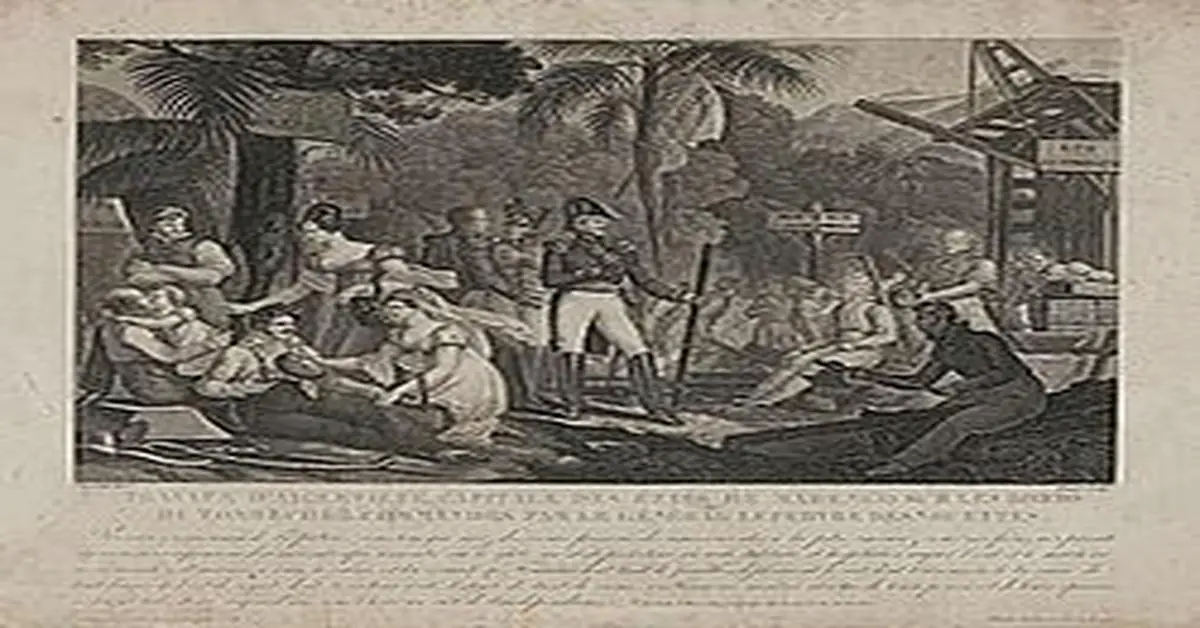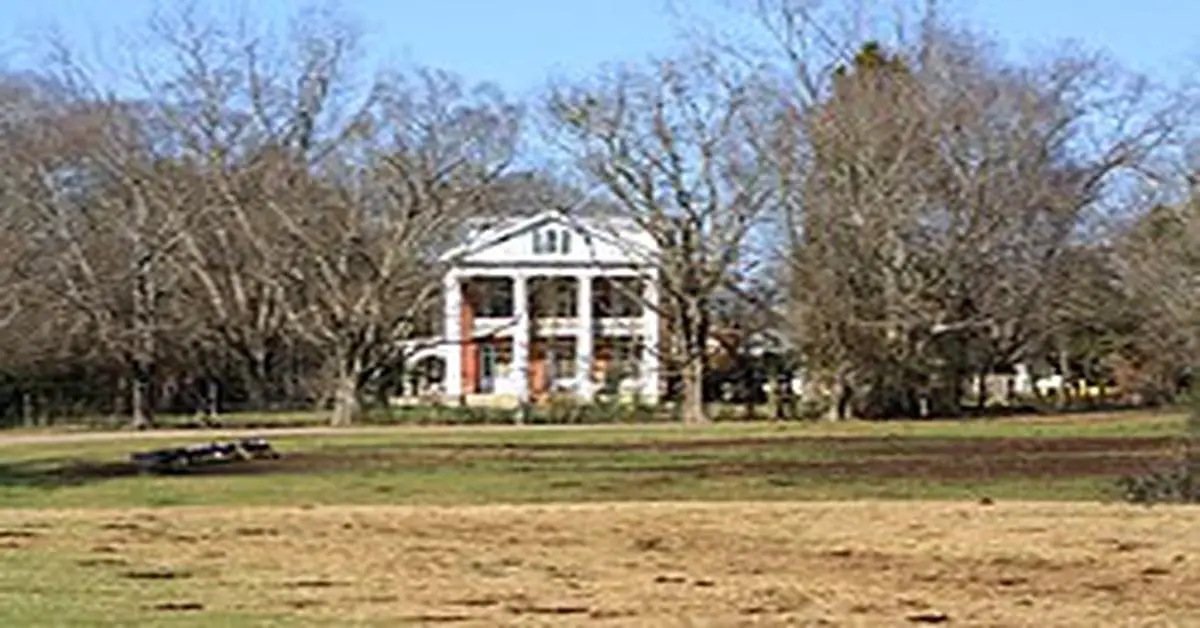You’ll find the ghostly remains of Bellefonte, Alabama’s first Jackson County seat, three miles northeast of Scottsboro. This once-thriving town, named from French words meaning “beautiful fountain,” peaked in the 1840s with 400 residents. Its decline began when citizens rejected a railroad depot in the 1850s, followed by Union forces burning the courthouse during the Civil War. Today, only scattered bricks and the historic cemetery with 229 graves reveal its fascinating past.
Key Takeaways
- Bellefonte became a ghost town after rejecting a crucial Memphis and Charleston Railroad depot in the 1850s, leading to Scottsboro’s rise.
- Union forces during the Civil War destroyed the courthouse and homes, erasing records and accelerating the town’s economic collapse.
- The town disappeared from census records by 1880, leaving only scattered bricks and a chimney from an old inn.
- Old Bellefonte Cemetery, containing 229 grave plots dating to 1826, remains the most significant remnant of the former county seat.
- The once-thriving town of 400 residents lost its county seat status to Scottsboro and gradually transformed into an abandoned site.
The French-Named Settlement’s Early Days
Although Bellefonte’s name combined the French words “belle” (beautiful) and “fonte” (fount), the settlement had no actual French colonial heritage. The romantic French naming was likely part of a broader trend in the early 19th century American South, where European-inspired names were popular for new settlements.
Despite its French-sounding name, Bellefonte reflected a Southern trend of adopting European names rather than any genuine French heritage.
You’ll find it interesting that French influence in Alabama was historically limited to the state’s lower third and had ended by 1763, long before Bellefonte’s founding. This town shares its name with several other locations, leading to the creation of a disambiguation page to help distinguish between them.
The earliest settlers, including Dr. George Washington Higgins and Stephen Carter, arrived in 1820 after Cherokee land cessions opened the area. They established the town on a 640-acre plot originally granted to James Riley through the 1819 Treaty.
Settlement patterns focused around a public square, and by incorporation in 1821, nearly 200 residents called Bellefonte home. The town’s water supply came from a beautiful spring nearby, which ultimately inspired its name.
Rise to County Seat Status
As Alabama’s legislature sought to establish formal governance in its northern territories, Bellefonte emerged as Jackson County’s first county seat through a series of strategic legislative actions in the 1820s.
You’ll find that Bellefonte’s significance grew when the state appointed five commissioners to oversee the county seat establishment, though permanent structures weren’t built until after 1828. Stephen Carter and George W. Higgins’ land donation secured the town’s position with a 100-year contract.
The town’s incorporation in 1821 brought nearly 200 residents, and by 1844, that number had doubled. The town attracted many professionals and politicians who contributed to its growing prominence.
You’ll see how Bellefonte’s role expanded with the construction of a courthouse and church, while the 1830 post office addition strengthened its administrative capabilities.
The town also served as an essential supply depot during Cherokee removal operations.
Life in Antebellum Bellefonte
During Bellefonte’s heyday as county seat, you’d find prominent lawyers and doctors conducting business around the public square, where two-story brick buildings housed shops and professional offices.
The town was established and incorporated in 1821, marking the beginning of its prominence in the region.
You could witness farmers bringing cotton and livestock to market while riverboats carried goods to and from the town’s landing points.
The Masonic Hall was built in the early 1850s, serving both as a school and community gathering place.
The town’s social fabric centered on the courthouse, post office, and church, where you’d see residents gathering for political meetings, collecting mail, and attending weekly services.
Thriving County Seat Era
While the French-inspired name “Bellefonte” promised beauty and flowing springs, the town’s reality matched its poetic aspirations in the early 19th century. As Jackson County’s first seat of government, you’d find Bellefonte architecture reflecting its prestigious status: a stately courthouse anchored the town center, while a church steeple pierced the skyline of the 1820s frontier settlement.
The town’s liveliness grew with its population, swelling to 400 residents by 1844. Community gatherings centered around the courthouse square, where you’d witness elections, judicial proceedings, and social events that knit the community together.
A post office established in 1830 connected you to the wider world, while donated land from prominent citizens like Stephen Carter and George W. Higgins enabled the town’s strategic expansion.
Daily Life and Commerce
The bustling streets of antebellum Bellefonte showcased a vibrant commercial hub centered around its carefully planned town square.
You’d find daily routines revolving around twelve thriving stores, where local markets buzzed with activity as merchants traded cotton, sugar, coffee, and manufactured goods.
The town’s two-story brick houses lined the square, while craftsmen worked diligently in blacksmith shops, wagon shops, and the local tanyard.
You could stop by the Belle Tavern or Mansion Hotel, where travelers and locals gathered to discuss business and politics.
The sights and sounds of keelboats loading cotton at the river port mixed with the steady flow of wagons bringing goods to market.
This dynamic commercial atmosphere supported a growing population of 400 residents who enjoyed the town’s orderly, prosperous character.
The town’s rich character was enhanced by its beautiful spring water, which provided a vital resource for the community’s daily needs.
The town’s prosperity would be short-lived, as Union forces destroyed Bellefonte during the Civil War, leaving it in ruins.
The Fateful Railroad Decision
As railroad expansion swept through northern Alabama in the mid-1850s, Bellefonte’s citizens made a decision that would seal their town’s fate: they rejected hosting a Memphis and Charleston Railroad depot within their community.
The railroad significance became immediately clear when influential settler Robert Thomas Scott seized the opportunity, securing rights-of-way near his property west of Backbone Ridge. Scott, who had served as newspaper editor, would go on to shape the region’s development.
You can trace Bellefonte’s decline directly to this pivotal moment. While Scott’s Mill (later Scottsboro) flourished with its new depot just three miles from Bellefonte’s courthouse, the economic consequences for Bellefonte were devastating.
The town watched helplessly as trade, population, and influence shifted toward Scottsboro. After Bellefonte burned during the Civil War, its lack of rail access guaranteed it would never recover its former prominence.
Civil War’s Devastating Impact

During the harsh winter of 1863-64, Sherman’s 15th Army Corps descended upon Bellefonte, releasing a wave of destruction that would permanently alter the town’s fate. The 34th Illinois Volunteer Regiment’s occupation brought devastating military strategies, including the burning of courthouse records and systematic foraging that stripped civilian resources without compensation.
You’ll find that the civilian hardships were immense. Union forces burned private homes, destroyed essential infrastructure, and depleted local food supplies. Nearly 250,000 Federal troops passed through Jackson County, leaving communities impoverished and hungry. The once prominent professionals who lived and worked in Bellefonte were forced to abandon their practices.
The courthouse’s destruction erased vital records dating before 1852, while Sherman’s December 17 order to collect all provisions without payment crippled local families. These actions shattered Bellefonte’s foundation, forcing residents to flee and eventually transforming this once-thriving town into abandoned ruins. Today, only a cemetery and inn chimney remain as silent witnesses to the town’s violent past.
From Bustling Town to Abandonment
Prior to the Civil War, you’d have found Bellefonte thriving as Jackson County’s seat, with a bustling courthouse, active post office, and hundreds of residents conducting daily business.
You’d witness its rapid transformation during the war years as Union forces burned the courthouse and homes, causing many residents to flee, while the town’s fateful decision to reject a railroad connection sealed its economic fate.
Growth Before Civil War
When Bellefonte secured its designation as Jackson County’s first seat in 1820, the town’s trajectory toward prosperity began to accelerate.
You’d have witnessed the community’s resilience as the population doubled from 200 to 400 residents between 1821 and 1844, with two-story brick businesses filling the town square.
Despite economic challenges, Bellefonte thrived as a political and legal hub, attracting prominent lawyers like Major Dimornay and Colonel Norwood.
The reliable spring water supply and strategic location near the Tennessee River’s steamboat traffic bolstered commerce.
By 1830, you’d have found a bustling post office, Methodist church, and courthouse serving the region.
Cotton farming and livestock management sustained the local economy, while the town’s role in Cherokee removal operations further cemented its regional importance.
Wartime Impact and Decline
The Civil War struck a devastating blow to Bellefonte’s prosperity as Confederate and Union forces ravaged the town, burning most structures to the ground. The war devastation left few buildings standing, with survivors desperately salvaging what they could.
Some residents managed to relocate entire structures to nearby Scottsboro, while others dismantled their homes to reuse materials elsewhere.
The economic collapse accelerated when you consider how quickly institutions vanished. The post office had already closed by 1859, and remaining businesses struggled to operate in the harsh post-war landscape.
Ghost Town’s Empty Legacy
Once a thriving community of 400 residents, Bellefonte’s transformation into a ghost town represents one of Alabama’s most dramatic municipal declines.
Today, you’ll find only scattered bricks, a solitary chimney from an old inn, and a cemetery – haunting reminders of the town’s former vibrancy. The ghost town nostalgia is palpable as you walk through what was once the bustling county seat of Jackson County.
After losing both its railroad connection and county seat status to nearby Scottsboro, Bellefonte’s population steadily dwindled until it vanished from census rolls by 1880.
What Remains Today: A Historical Legacy
Modern visitors to Bellefonte’s abandoned grounds will find sparse remnants of this once-thriving Alabama town. A solitary chimney, once part of the local inn, stands as the last structural sentinel of Bellefonte’s past.
You’ll discover the Old Bellefonte Cemetery, a vital focus of heritage tourism efforts, containing 229 grave plots with markers dating back to 1826.
Beyond these fragments, you’ll see only scattered bricks where buildings once stood. While the Jackson County Historical Association works on cemetery preservation, nature steadily reclaims the landscape.
The town’s legacy lives on through its connection to the nearby nuclear station project and its place in Cherokee removal history. What was once a bustling county seat of 400 residents now serves as a quiet symbol of Alabama’s evolving story.
Frequently Asked Questions
Are There Any Paranormal Activities Reported at the Bellefonte Cemetery?
While you’d expect solid proof from such a spooky spot, there’s only anecdotal evidence of ghost sightings and eerie encounters at this cemetery – mainly visitor reports of being watched and feeling uneasy.
What Happened to the Original Town Records After Abandonment?
You’ll find most town records were destroyed when Union soldiers burned them for warmth in 1863-64. What remained was likely lost when the courthouse burned, with no archival preservation efforts afterward.
Did Any Notable Historical Figures Ever Visit Bellefonte?
Like a fading star, Bellefonte’s famous visitors were mostly military – you’ll find General Sherman and General Logan led Union forces there, but no other notable historical figures graced its streets.
What Were the Primary Occupations of Bellefonte’s Residents Before Decline?
You’d find lawyers, doctors, merchants, politicians, and skilled craftsmen running local businesses, while surrounding residents focused on farming practices, including cotton production and livestock raising.
Are There Any Surviving Photographs of Bellefonte During Its Peak?
You won’t find any verified historic images of the town architecture during its peak – photography was rare in rural Alabama pre-1860s, and any potential photos would’ve been destroyed during the Civil War.
References
- https://www.fabledcollective.com/the-ghosts-of-bellefonte/
- https://www.onlyinyourstate.com/experiences/alabama/vacant-ghost-town-al
- https://www.alabamapioneers.com/bellefonte-ghost-town-2/
- https://www.nrc.gov/docs/ML1111/ML111160144.pdf
- https://www.onlyinyourstate.com/experiences/alabama/creepiest-ghost-town-bellefonte-al
- https://www.youtube.com/watch?v=Yk7iX4APnJU
- https://digitalalabama.com/alabama-ghost-towns/bellefonte-alabama/1297
- https://en.wikipedia.org/wiki/Bellefonte
- https://digitalalabama.com/alabama-civil-war/bellefonte-alabama/1297/
- https://encyclopediaofalabama.org/article/french-in-alabama-1699-1763/


